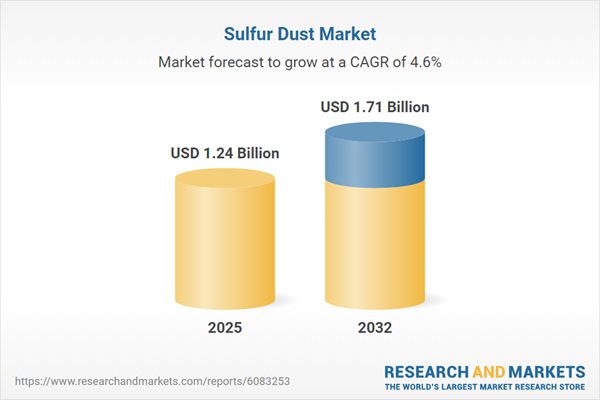Speak directly to the analyst to clarify any post sales queries you may have.
Senior leaders in agriculture, chemicals, and manufacturing are navigating a sulfur dust market shaped by regulatory, technological, and supply chain shifts. As demand diversifies and new compliance pressures emerge, understanding the landscape is crucial for resilient, future-ready strategies.
Market Snapshot: Sulfur Dust Market Size and Growth Outlook
The Sulfur Dust Market grew from USD 1.19 billion in 2024 to USD 1.24 billion in 2025. It is expected to continue growing at a CAGR of 4.59%, reaching USD 1.71 billion by 2032. Market expansion is being driven by the essential roles of sulfur dust in agriculture, chemical manufacturing, petrochemicals, and pharmaceuticals, alongside evolving regulatory requirements and ongoing adoption of advanced production technologies.
Scope & Segmentation: Unpacking the Sulfur Dust Industry
- Applications: Chemical manufacturing, fertilizers, petrochemicals, and pharmaceuticals. Key applications include sulfonation processes, sulfuric acid production, monoammonium phosphate, NPK fertilizers, urea ammonium nitrate, fuel desulfurization, polymer production, antibiotics, and sulfa drug synthesis.
- Product Types: Elemental sulfur, sulfur blends, and sulfur compounds, tailored for demanding industry requirements.
- Purity Grades: Agricultural, industrial, and technical grades, each aligned with specific regulatory and performance needs.
- End-User Industries: Agriculture, chemical, oil and gas, and pharmaceutical sectors leveraging tailored handling protocols and optimized dosing.
- Forms: Granular, powder, and prills, enabling operational versatility in application and storage.
- Sales Channels: Direct sales, distributors, and online retail, maximizing distribution reach from large-scale buyers to niche users.
- Regional Coverage:
- Americas: North America (United States, Canada, Mexico), Latin America (Brazil, Argentina, Chile, Colombia, Peru)
- Europe, Middle East & Africa: Europe (United Kingdom, Germany, France, Russia, Italy, Spain, Netherlands, Sweden, Poland, Switzerland), Middle East (United Arab Emirates, Saudi Arabia, Qatar, Turkey, Israel), Africa (South Africa, Nigeria, Egypt, Kenya)
- Asia-Pacific: China, India, Japan, Australia, South Korea, Indonesia, Thailand, Malaysia, Singapore, Taiwan
- Key Companies: UPL Limited, BASF SE, Corteva, Inc., ADAMA Ltd, Syngenta AG, Sipcam Oxon S.p.A., Gowan Company, LLC, Qingdao Haiwan Biochemistry Co., Ltd., Italpollina S.p.A., SAPEC Agro S.A.
Key Takeaways: Strategic Insights for Sulfur Dust Decision-Makers
- Environmental regulations are shaping application trends, especially in desulfurization and catalyst production.
- Investments in prilling, granulation, and logistics traceability are driving improvements in product quality and operational efficiency.
- Supply chain resilience is increasingly vital, with companies adopting digital monitoring and multi-vendor sourcing strategies.
- Collaboration between established producers and technology firms is enabling agile market responses and process optimization.
- Segmentation across end-users and regions uncovers targeted growth opportunities in fertilizer innovation and specialty compounds.
- Adoption of sustainable practices, such as circular economy models and byproduct reutilization, supports long-term value creation and compliance.
Tariff Impact: Navigating Cost and Supply Adjustments
United States tariffs enacted in 2025 have increased procurement complexity for sulfur dust stakeholders, particularly affecting imports from Canada and Europe. Buyers and manufacturers are engaging in multi-source hedging, inventory strategies, and tariff engineering to manage higher costs and maintain robust supply. Domestic producers are leveraging the altered trade landscape to expand capacity and offer enhanced value propositions, reinforcing the need for dynamic supply chain management and cross-border coordination.
Methodology & Data Sources: Ensuring Reliable and Comprehensive Insights
This report relies on a robust combination of primary interviews with industry executives, procurement managers, and technical experts, paired with secondary analysis of trade journals, company filings, and public datasets. Rigorous triangulation of data, supplemented by validation sessions with subject matter leaders, supports detail-rich, unbiased conclusions and actionable intelligence on the sulfur dust market.
The Sulfur Dust Market: Why This Report Matters
- Enables strategic planning by offering a granular view of demand drivers and key sector trends.
- Supports decision-making with region-specific intelligence and actionable recommendations for supply chain, technology, and compliance optimization.
- Equips leaders with the insights required to mitigate risks and harness new opportunities arising from technology adoption and regulatory changes.
Conclusion: Empowering Confident Market Navigation
Senior decision-makers will benefit from a holistic perspective on market drivers, segment opportunities, and trade dynamics. Leveraging these insights supports resilient strategies and positions organizations to capture value in a rapidly evolving sulfur dust sector.
Table of Contents
3. Executive Summary
4. Market Overview
7. Cumulative Impact of Artificial Intelligence 2025
Companies Mentioned
The companies profiled in this Sulfur Dust market report include:- UPL Limited
- BASF SE
- Corteva, Inc.
- ADAMA Ltd
- Syngenta AG
- Sipcam Oxon S.p.A.
- Gowan Company, LLC
- Qingdao Haiwan Biochemistry Co., Ltd.
- Italpollina S.p.A.
- SAPEC Agro S.A.
Table Information
| Report Attribute | Details |
|---|---|
| No. of Pages | 196 |
| Published | October 2025 |
| Forecast Period | 2025 - 2032 |
| Estimated Market Value ( USD | $ 1.24 Billion |
| Forecasted Market Value ( USD | $ 1.71 Billion |
| Compound Annual Growth Rate | 4.5% |
| Regions Covered | Global |
| No. of Companies Mentioned | 11 |









